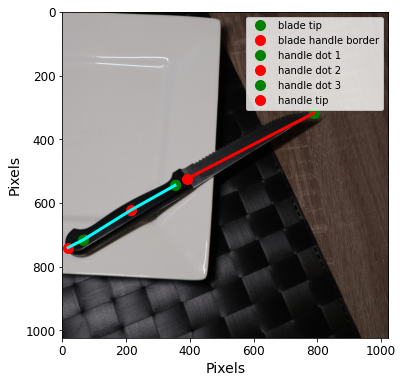Cutlery Classifier
End-to-end ML pipeline for robot gripper.
You can execute our code yourself on Deepnote

The lines show the distinct detections of the handle and the blade of the knife.
A small robot gripper has to detect cutlery and determine a suitable grip pose. To this end a computer vision pipeline was constructed.
The general ML cookbook looks something like this:
- Overview
- make a plan
- get the data
- representiveness
- need to annotate
- use simulation to obtain data (well suited for reinforcement learning)
- check possibilities for data augmentation data augmentation
- Inspect Data, gain insights
- GOAL: develop intuition
- find outliers
- determine physical meaning
- Prepare data
- GOAL: expose the underlying patterns to the ML algorithm
- how2translate ‘task’ to ‘ML problem’
- Feature selection/ feature engineering
- what do the measurements represent
- data compression
- which variance is informative
- which variance can be removed
- data transforms to deal with:
- missing values
- GOAL: expose the underlying patterns to the ML algorithm
- Explore different models
- for robotics fast inference required as part of control loop
- training time more forgiving
- “more data vs. better model” ROI consideration
- Fine tune your model
- Optimise hyperparameters
- Present your solution
- ensure results are reproducible
- Launch, monitor and maintain your system
Additionally, we compared the performance of classical ML methods with newer DL methods and our results can be seen in the published notebook.